Because they are so ubiquitous, the Columba Livia Pigeon has become an integral part of any urban space. They have successfully settled everywhere: on farms and farming equipment, in the parks and on city squares, construction zones and in gardens, and especially near domestic bird feeders. Some compare pigeons with flying rats and even the most peaceful citizens have considered poisoning these pests when they are surprised to see their new car covered in bird poo. You may ask yourself, as millions around the world have, “Can anything take down this common enemy?”. Maybe there is…
In this review, we will explain how to get rid of pigeons permanently, what the scientists recommend and whether toxicants are really worth using. We will then cover the best pigeon deterrents: netting, spikes, an electric powered fences, a motion activated water sprinklers, and chemical gel repellents, all while discussing professional opinions and customers’ feedback.
Excessive amounts of feces, which are both unaesthetic and harmful as they cause plants to die and metals to rust, are a sure sign of a flock’s presence. Pigeons can pollute a farmer’s cereal grains in agricultural enterprises. Moreover, pigeons are carriers of such severe diseases as ornithosis, encephalitis, and salmonellosis. However, the University of Missouri experts consider that human infection is unlikely.
However, few people realize that a thick layer of pigeon feces on a cornice near your bedroom or office window is a source of fungi. Histoplasmosis attacks human lungs and can lead to death.
It should be pretty obvious that to eliminate a pigeons’ excessive begging for food at your doorstep a person should stop feeding them. My neighbor decided to quit feeding pigeons after she found out that it was actually illegal in our town. Would you believe that the pigeons “retaliated”? They came back everyday for at least 2 weeks and pulled up her potted plants and terrorized her front yard. The eventually learned there was no more easy food and are only occasional visitors now. At least consider refraining from feeding them on your balcony, a habit adopted by many city dwellers. A balcony can become a roosting place for them that they never want to leave! To avoid nesting, never leave trash and old furniture accessible to these birds. Farmers must store grain properly and limit the birds’ access to water if possible.
It’s not very difficult to prevent pigeons from nesting although they are capable of fending off any notch or cavity. Try to make attic windows, ventilation hatches, cornices, window sills and similar surfaces uncomfortable to land on. Stainless steel, plastic or nylon netting with holes ¼ of an inch wide is suitable for that. You can protect architectural elements with the help of an ultraviolet-resistant polypropylene net with inch wide holes. It’s best to opt for a versatile black net or paint it to the color of the building. Methods to attach the netting vary but sturdy outdoor rated clips should work. This method is not only effective but also long-lasting as the barrier will serve you for about ten years.
In household structures, the net is attached to the lower part of the rafters to prevent the birds from settling inside. If necessary, make slits on Velcro as doors. Hanging a plastic strip door curtain is also appropriate.
Adjusting the cornice angle to 45 degrees or more will help you get rid of pigeons knocking on your windows. Special polycarbonate plates suitable for any L-shaped projections are available. These plates can be glued or nailed to any surfaces. Such simple engineering won’t let the birds land on the building. The Scientific Review Team here at StopPestInfo is really a fan of these types of mechanical solutions. If a carpenter properly and beautifully makes these pigeon proof upgrades to your house it can be a valuable investment in your home in respect to resale value and reduced maintenance costs.
Plastic or stainless steel bird spikes are another option. Their sharp teeth are an insurmountable barrier for almost all bird species. The spikes are just as universal as the nets as they can be attached to any surface on their own or with the help of outdoor construction adhesive. Clean the spikes regularly so that they do not lose their properties. Metal Spikes can be spray painted to match your house therefore maintaining all the beauty and charm of your investment. Choose a spray paint that is specially made for metals.
If neither spikes nor nets seem aesthetic to you, use stainless birdwire. The wire is to be hung between metal poles supplied together with the coil so that it springs slightly. This minimalistic design is appropriate even on handrails or facades of ancient buildings.
Specialists also mention electric shock bird control systems among physical barriers. David E. Williams and Robert M. Corrigan claim that when pigeons make contact with the conductors and the cable, they receive a shock that repels but does not kill them. The cable can be installed in situations also suitable for barbed wires, stretched steel wires or monofilament lines. Although these devices and their installation are usually labor intensive and/or expensive, their effectiveness, in some cases, justifies the investment.
The service life of such a device is about eight years. Despite guarantee of safety, the device is more suited for deserted places, such as industrial venues or roofs.
To summarize, we’d like to say that physical barriers are the most effective method of pigeon removal.
Visual and Sonic Methods
Pigeons are not wild woodland birds so they can be scared off with neither loud noise or reflected light. Ultrasonic devices are tempting, but the scientists do not trust them. They advise not to waste money buying predator statues or acoustic systems. These urban parasites area as adaptable as they are annoying.
Sticky Gel and Chemical Repellents
The low price of pigeon Gel Repellents and usability (all you have to do is squeeze them on the cornice) attracts many users. Most attempts are successful in getting rid of pests, but some are left unsatisfied as the gel material has its own drawbacks.
The main drawback is that they pose a potential threat to animals, even if they are non-toxic. The most popular sticky repellents can glue a bird’s plumage preventing them from flying. This is especially dangerous for smaller species which can accidentally get into a pigeon sticky trap. This is rare in areas with pigeon infestations as they push all the other species out of their area.
In addition, trash can stick to the treated area over time, so the birds will no longer feel discomfort on touching the sticky surface. However, some manufacturers noticed this and designed gels that get covered with a protective layer when in contact with the oxygen, thus prolonging their action. A single application is sufficient for a year of protection.
The dried repellent is difficult to clean off and it leaves stains. Nevertheless, a thick layer of it should be applied as the distance between the strips should not exceed three-four inches. Some users have recommended to protect the surface with a waterproof tape or plastic beforehand.
A Chemical Repellent called Naphthalene (do not confuse it with POB – Poradichloro benzene) is allowed for use in non-residential buildings for repelling pigeons. Its sharp artificial odor will make the entire flock leave. Five pounds of the concentrate are required to cover 2000 cubic feet. After the birds fly away, shut any holes through which they could potentially return. Remember that naphthalene is harmful for health, especially for allergy patients. Owners of abandoned warehouses may consider this method.
Method/Product
How, When and Where Used Best
Advantages
Disadvantages
Netting
For protection of attic windows, ventilation hatches, cornices, window sills, flower beds and plantings.
Accessible, long-lasting, and versatile.
Unaesthetic.
Bird Spikes
On house cornices and city fences.
Prevent pests from landing on protected surfaces.
Unaesthetic, requires occasional cleaning.
Birdwire
On house cornices, handrails, fences, roofs, facades.
Repels birds effectively, is more appropriate and aesthetic than spikes.
Check the integrity of the wire regularly.
Electric Shock Bird Control Systems
To protect any surfaces or places attacked by pigeons
Are long-lasting as their life time is 8 years. They repel and do not kill birds.
Are expensive and suitable for deserted places, such as roofs and industrial venues.
Chemical Repellents: Gels, Sprays, Naphthalene
Various surfaces, e.g., cornices, roofs, handrails, lawns and monuments, can be treated.
Cause a lasting reflex of ever avoiding treated areas.
Some compounds are toxic and require proper application in accordance with the manual.
Top-8 Pigeon Deterrents
Taking into account the specialists’ opinions, we’ve listed a variety of products to choose from for your particular situation: netting, spikes, an electric powered fence, a motion activated water sprinkler and chemical repellents.
BirdBlock Bird Netting Reusable Mesh Netting Bird Protection
Sometimes, simple but tested devices are way more effective than novelties. The StopPestInfo Editorial Research Team notes that many homeowners and businesses have been able to remove pigeons from balconies with the help of netting mounted with metal clamps. Black polypropylene net is ultraviolet-resistant and will last for several years. Fruit trees and plantings can also be covered with this versatile material as long as you fix the edges so that the birds do not get trapped. The net is sold in a roll; the larger it is, the higher the price. Cut it to size and save the rest for another project.
BirdBlock Bird Netting, 28 feet x 28 feet: Check current price
Spikes
As we discussed, physical barriers are the best urban protection from pigeons and easy installation makes them the most popular choice. For instance, simply glue plastic spikes to the cornice. Polycarbonate and stainless steel spikes by Bird-X are very popular. The price depends on the material and length of spikes, varying from 10 to 100 feet. Plastic spikes create a denser fence, but they are more fragile so you’d better use metal ones against these audacious pests. Metal spikes can be attached even to irregular surfaces due to their flexibility. Invest in a set of spiked polypropylene strips 10×48.8 cm in size to protect fences and gates.
Plastic Polycarbonate Spikes: Check the current price
Stainless Steel Spikes: Check current price
Bird Spikes – Set of 10 x 48.8 Cm Anti-climbing Security: Check current price
Fi-Shock EAC10A-FS Super 525 Energizer, 10-Acre
Above, we mentioned electric shock bird control systems among the products recommended by the scientists. This device creates an electric fence against small pets, such as rabbits or chickens. Judging by the comments, it can be adjusted for deterring pigeons from the lot. The StopPestInfo Staff would like to note that this method could be used in the country for foxes, the suburbs for squirrels, and the city for pigeons! However, the manufacturer does not directly confirm the effectiveness of the device against pigeons. You will have to buy shock tape of appropriate length separately.
Fi-Shock EAC10A-FS Super 525 Energizer, 10-Acre: Check the current price
Orbit 62100 Yard Enforcer Motion Activated Sprinkler with Day and Night Detection Modes
One can hardly invent anything better than a motion activated water sprinkler for lawn and open pool protection. The sprinkler has a 120-degree motion sensor that works even at night and repels both birds and small to medium sized animals. Should the intruder approach closer than 35 feet, the sprinkler will release a jet of water. The device can also be set to a thirty-minute watering mode. The sprinkler requires four batteries and has barely any quality claims. The SPI Team recommends this product for a variety of pests. It is a great tool for your “tool box” and can be moved around the yard seasonally for maximum effectiveness. It works on the neighbor kids trying to get to the strawberry patch too!
Orbit 62100 Yard Enforcer Motion Activated Sprinkler: Check current price
Bird-X Bird-Proof Gel Repellent
If you don’t want to spoil the view out of the window with metal spikes on the cornice, opt for “liquid nails”. In theory, this gel can be used anywhere but handrails or pool rails as their surface will become too sticky. A downside in a dusty area is this transparent repellent darkens from dirt and dust so it can be hardly called invisible. Nevertheless, the gel is non-toxic and can be washed or wiped off relatively easy. A set of three tubes will be sufficient for a thirty feet long gel strip. Judging by the description, it’s enough to apply the gel once in 1.5 years given that you live in a moderate climate (6 months in extremely dusty climates).
Bird-X Bird-Proof Gel Repellent: (3-pack) Check the current price
Bird-X Bird Stop Liquid Deterrent
Methyl anthranilate, a safe component of essential oils and cosmetics, is the base of this repellent. Bird Stop is a concentrate of this substance and it therefore has a sharp smell and unpleasant taste. According to the manual, the repellent is to be dissolved in water and then sprayed over an open territory, such as garden, lawn, roof, over the siding or near vegetable plantings. The manufacturer assures that Bird Stop deters all of the common bird species, including pigeons. (Plenty of negativity is expressed claiming that the spray is useless against geese – good thing we are talking about pigeons here…) If the volume of the pack (one gallon) is a disadvantage, share the cost with neighbors with similar issues. Nevertheless, Bird Stop can be recommended for use in rural areas where there are fewer pigeons than other pest birds. This is a humane alternative to toxicants.
Bird-X Bird Stop Liquid Bird Deterrent: Check current price
Best Pigeon Deterrents Comparative Chart
| Product | Type | Use | Price |
BirdBlock Bird Netting  | Netting | Use as a barrier and mount it to your balcony, cover plantings etc. | Price |
Bird-X Plastic Polycarbonate Spikes Kit with Adhesive Glue  | Spikes | Install on a cornice or a windowsill. |  |
Bird-X Stainless Steel Spikes Kit | Spikes | Price |
|
Bird Spikes – Set of 10 x 48.8 Cm Anti-climbing Security ![Upgraded Defender Spikes for Bird, Cat, Pigeon and Small Animals - Protect Your Sofa, Garden, Outdoor Walls, Anti Theft Climb, Plastic Security Fence Spikes - 8pack [12FT]](https://m.media-amazon.com/images/I/41w2WLCcGTL._SL75_.jpg) | Spikes | For protecting fences and gates. |  |
Fi-Shock EAC10A-FS Super 525 Energizer  | Electric powered fence charger | As a barrier in places of birds’ activities. | Price |
Orbit 62100 Yard Enforcer Motion Activated Sprinkler  | Motion activated water sprinkler | Connect to a water source and install on the lot across the objects to be protected. |  |
Bird-X Bird-Proof Gel Repellent  | Chemical repellents | Leave a strip of “liquid nails” on cornice and roof. |  |
Bird-X Liquid Deterrent  | Dissolve in water and spray over open areas, e.g. lawns, roofs etc. | Price |
|
Should Pigeon Poison Be Used?
Physical destruction must be the most radical measure of pest control. However, before you act, clarify both the legal and sanitary aspects. Although pigeons are not on the list of protected species, check your state legislation. If there is not a ban on killing pigeons, think how to do it safely.
One of the options is to access exterminators as they are the only ones who have access to registered pigeon control toxicants. For instance, only USDA APHIS-Wildlife Services employees and contractors are permitted to use DRC-1339. Avitrol is one of the most effective pesticides; its use is also limited.
University of Florida’s William H. Kern explains that in order to get an Avitrol permit, you must adequately describe in your application how you will protect non-target birds from accidental poisoning. Be ready to scare away all non-target birds that come to the feeding station, even if it means scaring away pigeons. Protecting non-target birds is your responsibility. When Avitrol or any other avicide is used, have crews patrolling the area to collect downed birds quickly.
When looking for pigeon poison pellets, bear in mind that pets can become innocent victims of this poison, so it is rational to only use them away from residential areas, e.g. on farming and agricultural areas.
The University of Missouri scientists Robert A. Pierce and Kevin McGrath warn that a bird-control program using repellents and toxicants requires careful attention to detail. Be sure to follow all product label instructions when using repellents or toxicants. Do not take shortcuts, as they may be dangerous or cause the program to fail.
Innovations
This innovative idea is definitely worth your attention. In order to adjust the cornice’s angle and make it impossible for a bird to nest, BirdBarrier’s polycarbonate inclined plate can be used. It is available in beige and gray. The plate’s base is glued to or screwed to any L-shaped projection, be it a cornice, a beam or a piece of decoration. The lack of an even surface will make the birds search for a new home. The price for this barrier depends on the length and width of the plate and ranges from ~$22.50 to ~$218.30.

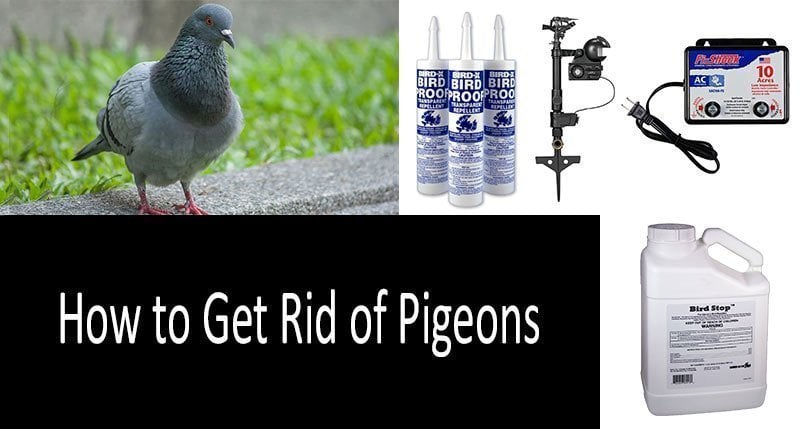








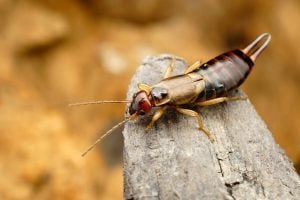
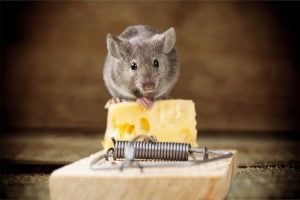
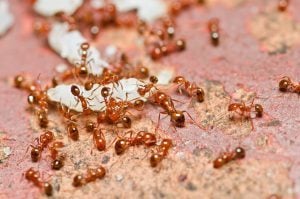
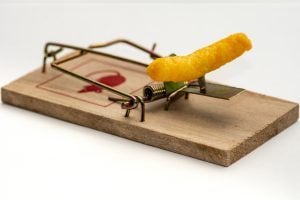
1 thought on “How to Get Rid of Pigeons with 8 Best Repellents and Deterrents from $12 to $218”
Skip the sticky bird repellent. I tried it on my balcony and it didn’t work, and it was a huge pain to clean up afterwards.